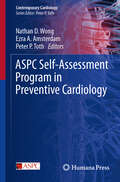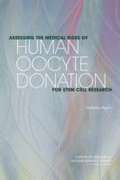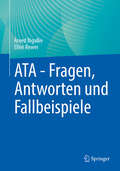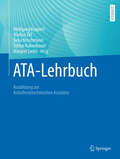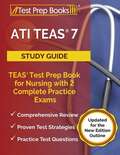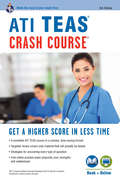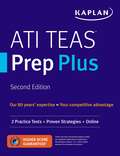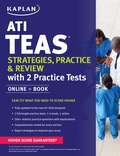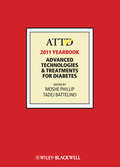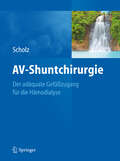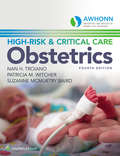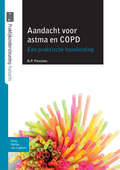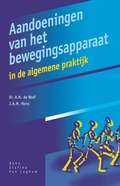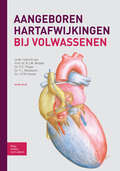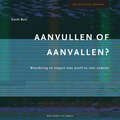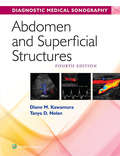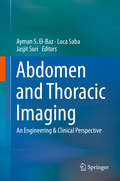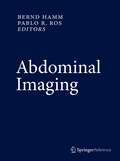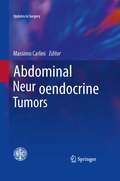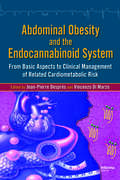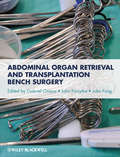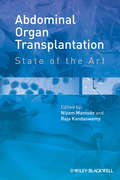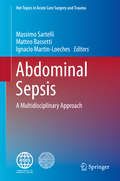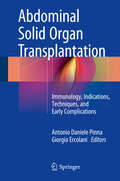- Table View
- List View
ASPC Self-Assessment Program in Preventive Cardiology (Contemporary Cardiology)
by Peter P. Toth Nathan D. Wong Ezra A. AmsterdamThis book is a unique, comprehensive board review dedicated solely to preventive cardiology. This volume is a companion work to the ASPC Manual of Preventive Cardiology. The book is comprised of a series of questions, each which addresses a core issue in preventive cardiology. Each question is accompanied with a correct answer key as well as a discussion of why the chosen response is correct, and the others are incorrect. Answers are supported by illustrations and discussion of contemporary literature when applicable. The book also provides references for additional study. This book contains questions written by many of the original authors who contributed to the ASPC Manual of Preventive Cardiology. This book, along with the ASPC Manual of Preventive Cardiology, accompanies the ASPC Experts Course in Preventive Cardiology.The ASPC Self-Assessment Program in Preventive Cardiology is a valuable resource for cardiologists and other specialists, as well as primary care clinicians (including internists, family physicians, nurse practitioners, and physician assistants) who seek additional training and expertise in cardiovascular disease prevention.
ASSESSING THE MEDICAL RISKS OF HUMAN OOCYTE DONATION FOR STEM CELL RESEARCH: Workshop Report
by Institute of Medicine National Research Council of the National AcademiesThe National Academies Press (NAP)--publisher for the National Academies--publishes more than 200 books a year offering the most authoritative views, definitive information, and groundbreaking recommendations on a wide range of topics in science, engineering, and health. Our books are unique in that they are authored by the nation's leading experts in every scientific field.
ATA - Fragen, Antworten und Fallbeispiele
by Ellen Rewer Arved BigalkeSie sind in der ATA-Ausbildung und wollen Ihr fachliches und berufsspezifisches Wissen nach den Kompetenzschwerpunkten überprüfen. Mit diesem Übungsbuch können Sie das systematisch und selbstständig: Anhand von unterschiedlichen Fragetypen, wie Zuordnungsfragen, Multiple-Choice-Fragen und Richtig-Falsch-Fragen, wiederholen Sie Ihr Wissen und festigen das Gelernte zu den Themen: Aufgaben in der Anästhesievorbereitung und -durchführung, Versorgung von Patienten im Aufwachraum, Vorgehen in Notfällen sowie zu relevanten rechtlichen Vorgaben, Qualitätsmanagement und zu Grundlagen der Kommunikation. Alle Lerninhalte sind den aktuellen Kompetenzschwerpunkten (ATA-OTA-APrV, Anlage 1) zugeordnet; Fallbeispiele ermöglichen Ihnen entscheidungsorientiert zu Lernen. Die ideale Ergänzung zum ATA-Lehrbuch: So können Sie sich optimal auf die Abschlussprüfung vorbereiten!
ATA-Lehrbuch: Ausbildung zur Anästhesietechnischen Assistenz
by Margret Liehn Wolfgang Koppert Markus Eiß Sirka Nitschmann Stefan RabenbauerDieses Lehrbuch begleitet Auszubildende optimal während ihrer dreijährigen Ausbildung zur anästhesietechnischen Assistenz. Alle Tätigkeiten für die prä-, intra- und postoperative Begleitung von Patienten werden praxisnah vermittelt, Aufgaben in den Anästhesiebereichen und die berufsspezifischen Inhalte systematisch und anschaulich beschrieben. Fallbeispiele, Merksätze und praxisnahe Hinweise erleichtern das Lernen, zahlreiche Abbildungen veranschaulichen Zusammenhänge und Fragen am Ende jeden Abschnitts helfen das Gelernte zu überprüfen.Das Buch richtet sich nach der aktuellen Ausbildungs- und Prüfungsverordnung sowie dem aktuellen Anästhesietechnischen und Operationstechnischen Assistentengesetz (ATA-OTA-G): Jedem Kapitel sind die jeweiligen Kompetenzschwerpunkte vorangestellt. Das interdisziplinäre und interprofessionelle Herausgeber- und Autorenteam teilt in diesem Buch sein Fachwissen und seine langjährige Erfahrung in der Anästhesie und Lehre. Ideal für Auszubildende zum täglichen Gebrauch und ein erfolgreiches Lernen; für Lehrende und Dozenten die ideale Vorbereitung auf den Unterricht!
ATI TEAS 7 Study Guide: TEAS Test Prep Book for Nursing with 2 Complete Practice Exams
by Joshua RuedaTest Prep Books' ATI TEAS 7 Study Guide: TEAS Test Prep Book with 2 Complete Practice Exams [Updated for the New Edition Outline] Made by Test Prep Books experts for test takers trying to achieve a great score on the ATI TEAS exam This comprehensive study guide includes: Quick Overview: Find out what's inside this guide! Test-Taking Strategies: Learn the best tips to help overcome your exam! Introduction: Get a thorough breakdown of what the test is and what's on it! Subarea I—Reading: Key Ideas and Details, Craft and Structure, and Integration of Knowledge and Ideas Subarea II—Mathematics: Number and Algebra, and Measurement and Data Subarea III—Science: Human Anatomy and Physiology, Life and Physical Sciences, and Scientific Reasoning Subarea IV—English and Language Usage: Conventions of Standard English, Knowledge of Language, and Vocabulary Acquisition Practice Questions: Practice makes perfect! Detailed Answer Explanations: Figure out where you went wrong and how to improve! Disclaimer: *TEAS® is a registered trademark of the Assessment Technologies Institute®, which is unaffiliated, not a sponsor, or associated with Test Prep Books. Studying can be hard. We get it. That's why we created this guide with these great features and benefits Comprehensive Review: Each section of the test has a comprehensive review created by Test Prep Books that goes into detail to cover all of the content likely to appear on the test. ATI TEAS Practice Test Questions: We want to give you the best practice you can find. That's why the Test Prep Books practice questions are as close as you can get to the actual test. Answer Explanations: Every single problem is followed by an answer explanation. We know it's frustrating to miss a question and not understand why. The answer explanations will help you learn from your mistakes. That way, you can avoid missing it again in the future. Test-Taking Strategies: A test taker has to understand the material that is being covered and be familiar with the latest test taking strategies. These strategies are necessary to properly use the time provided. They also help test takers complete the test without making any errors. Test Prep Books has provided the top test-taking tips. Customer Service: We love taking care of our test takers. We make sure that you interact with a real human being when you email your comments or concerns. Anyone planning to take this exam should take advantage of this Test Prep Books study guide. Purchase it today to receive access to: ATI TEAS review materials ATI TEAS practice test questions Test-taking strategies
ATI TEAS Crash Course® Book + Online
by John AllenNEW! REA’s ATI TEAS Crash Course®Perfect for nursing and allied health program applicantsIn August 2016, the ATI TEAS exam replaced the TEAS V. The ATI TEAS, already the most widely-used nursing school admission exam in the U.S., is now also used for allied health program admission nationwide. REA’s ATI TEAS Crash Course® is aligned with the most recent exam changes to the TEAS, or Test of Essential Academic Skills. Our ATI TEAS Crash Course® features easy-to-read review chapters that cover every exam objective in reading, mathematics, science, and English and language usage. A full-length online practice exam comes with automatic scoring and detailed explanations of answers. Helpful diagnostics pinpoint where test candidates are strongest and where they need to focus their study. The new ATI TEAS allows for one unified test to cover BSN, ADN, PN, and Allied Health programs. The ATI TEAS test blueprint has been revised to align with evolving developments in the nursing field and the curriculum, creating different points of emphasis on the test. In addition, the number of questions allotted to each content area has been changed, and examinees now may use an on-screen calculator. About REA’s Prep:- A complete ATI TEAS course in a concise, time-saving format - Targeted review covers only the material that will actually be tested - Strategies for answering every type of question - Online practice exam pinpoints your strengths and weaknesses
ATI TEAS Prep Plus: 2 Practice Tests + Proven Strategies + Online (Kaplan Test Prep)
by Kaplan NursingKaplan's ATI TEAS Prep Plus provides comprehensive content review, realistic practice, and expert advice to help you face the test with confidence and get into the school of your choice.Kaplan's content review and practice questions are developed and tailored to the TEAS 6 for the most up-to-date prep. Our exam-focused instruction and targeted practice help you make the most of your study time.The Best ReviewTwo full-length practice tests with comprehensive explanations of every question50-question online Qbank for additional test-like practiceMore than 300 additional practice questions and explanations to develop your skillsExpert review of all TEAS content areas: Reading, Math, Science, and English and Language UsageGlossaries to help you understand the key terms in each content areaExpert GuidanceOur practical test-taking strategies and study techniques help prepare you for even the hardest conceptsKaplan's expert nursing faculty reviews and updates content annually.We invented test prep—Kaplan (www.kaptest.com) has been helping students for 80 years. Our proven strategies have helped legions of students achieve their dreams.
ATI TEAS Strategies, Practice & Review with 2 Practice Tests: Online + Book
by KaplanExactly what you need to score higher Schools of nursing and allied health use the Test of Essential Academic Skills (TEAS) to assess applicants for admission. In August 2016, the ATI TEAS replaced the TEAS V. With exam-focused instruction and targeted practice, Kaplan’s ATI TEAS Strategies, Practice & Review with 2 Practice Tests provides the comprehensive preparation you need to achieve the best score possible and get into the school of your choice. Features: * 2 full-length practice tests with comprehensive explanations of every question * 50-question online Qbank for additional test-like practice * 300+ additional practice questions and explanations to develop your skills * Expert review of all TEAS content areas: Reading, Math, Science, and English and Language Usage * Kaplan methods to prepare you for even the hardest concepts * Practical test-taking strategies and study techniques * Glossaries to help you understand the key terms in each content area
ATTD 2011 Yearbook
by Moshe Phillip Tadej BattelinoThe traditional agents for controlling the levels of glucose in the blood remain important therapies but they have their downside from the point of view of tolerability and side effects. Moreover, they appear not to be able to counter the natural history deterioration of the disease in terms of the onset of diabetic-related complications. Recent years have seen an influx of new treatment therapies and technologies aimed at achieving better glycaemic control for diabetic patients such as liraglutide (Novo Nordisk) and saxagliptin (BMS/Astra-Zeneca) and insulin pumps, away from the more traditional therapies used (classic insulin therapy, oral hypoglycaemics). This book outlines these new technologies/treatments by collating the best journal articles published in the last year, and providing expert analysis on each one. Advanced Technologies and Treatment for Diabetes 3E brings together and critically analyses the last year's most important articles published in the world's leading medical journals on this topic. Chapters are focused on the most current hot topic areas such as: new methods of insulin delivery; internet and IT use in treatment of diabetes; bariatric surgery & diabetes; and immunotherapy for type 1 diabetes. Each chapter includes abstracts of the published articles, scientific conclusions made, as well as annotations and a comments and analysis section from the relevant chapter editor, each of which being a well-known expert in the field. All researchers in the fields of diabetes, endocrinology and metabolism will find this book extremely useful, as will diabetes technology developers, and specialist endocrinologists involved with the care of diabetic patients.
AV-Shuntchirurgie: Der adäquate Gefäßzugang für die Hämodialyse
by Hans ScholzDie längere Lebenserwartung von Dialysepatienten und die Zunahme von Diabeteserkrankungen führen dazu, dass Shuntoperationen öfter und häufig wiederholt durchgeführt werden müssen. Ausgehend von seiner langjährigen klinischen und wissenschaftlichen Arbeit auf dem Gebiet der Shuntchirurgie beantwortet der Autor Fragen zur Auswahl des individuell sinnvollsten Eingriffs und zur Beherrschung von Komplikationen. Der Band enthält über 300 detaillierte Zeichnungen zum Prinzip der einzelnen Eingriffe und zum operativen Vorgehen.
AWHONN's High-Risk & Critical Care Obstetrics
by Nan H. Troiano Patricia Witcher Suzanne BairdDevelop top-level guidelines for high-risk and critically ill pregnancy women with AWHONN High-Risk & Critical Care Obstetrics, 4th Edition, an official publication of the Association of Women’s Health, Obstetric & Neonatal Nurses (AWHONN). This comprehensive analysis of critical care obstetrics concepts offers summary of research findings and top-notch clinical expertise. This is the expert guidance you need to navigate complex patient conditions and promote safe, effective perinatal care.
Aandacht voor Astma en COPD
by Albert SchoenmakerSteeds meer patiënten met astma- en COPD hebben contact met de praktijkondersteuner van de huisarts. Om eenduidige informatie en duidelijke adviezen over medicatie en behandeling te geven, is het voor de praktijkondersteuner daarom van belang de kennis van astma en COPD voortdurend up-to-date te houden. Aandacht voor astma en COPD levert hieraan een belangrijke bijdrage. Aan bod in Aandacht voor astma en COPD komen onder andere kwaliteit van de zorgverlening in de praktijk, het onderzoek van de patiënt, diagnostiek, medicamenteuze en niet-medicamenteuze behandeling en astma bij kinderen. Uitgangspunt bij deze complete handleiding zijn de drie NHG-standaarden Astma bij Kinderen, Astma bij Volwassenen en COPD. Verder baseert Aandacht voor astma en COPD zich op internationale richtlijnen; en worden de resultaten van wetenschappelijk onderzoek vertaald naar de praktijk van de zorg. De diverse casussen met uitwerkingen verhelderen hoe de richtlijnen voor goede astma- en COPD-zorg in de praktijk kunnen worden uitgevoerd. Aandacht voor astma en COPD is het tweede deel in de POH-reeks; een reeks primair bedoeld voor praktijkondersteuners, praktijkverpleegkundigen en praktijkondersteuners in opleiding, maar zal daarnaast zeker ook nuttig zijn voor huisartsen. Door aandacht te besteden aan een diversiteit aan praktische onderwerpen, krijgt de praktijkondersteuner handvatten geboden die ter ondersteuning zullen zijn bij de uitoefening van het dagelijks werk binnen de praktijk.
Aandoeningen van het bewegingsapparaat: In de algemene praktijk
by A. N. Wolf J. M. A. MensDit boek is het vervolg op Onderzoek van het bewegingsapparaat: fysische diagnostiek in de algemene praktijk van dezelfde auteurs. Werd in het eerste deel de nadruk gelegd op de praktische uitvoering van het lichamelijk onderzoek en de interpretatie van de gegevens, in dit tweede deel gaan de auteurs in op de in de praktijk meest voorkomende categorieën aandoeningen: arthritis, artrose en "weke delen letsel". Een ongebruikelijk kenmerk van dit boek is het vermelden van "statements". De benadering van klachten van het bewegingsapparaat berust meer op theoretische overwegingen en langdurige praktijkervaring dan op de resultaten van wetenschappelijk onderzoek. De auteurs hebben dit aspect willen benadrukken door definities en praktische uitgangspunten in de vorm van afzonderlijke, omkaderde statements weer te geven. Het zijn geen waarheden, maar soms provocerende uitspraken. Deze kunnen worden gebruikt als vuistregels voor de dagelijkse praktijkvoering, maar ook als uitgangspunten voor de ontwikkeling van wetenschappelijk onderzoek.
Aangeboren hartafwijkingen bij volwassenen
by P. G. Pieper B.J.M. Mulder F. J. Meijboom J.P.M. HamerDit boek behandelt de belangrijkste aangeboren hartafwijkingen bij volwassenen. In een helder overzicht, thematisch in hoofdstukken geordend, beschrijven de auteurs de pathofysiologie van de afzonderlijke hartafwijkingen en relevante ontwikkelingen op het gebied van diagnostiek,therapie en prognose. Zij gaan hierbij bovendien in op obstetrische, genetische en psychosociale aspecten. De herziene, derde druk van deze uitgave - het enige Nederlandstalige leerboek over dit onderwerp - behandelt de nieuwste inzichten en ontwikkelingen op het gebied van zorg voor volwassenen met een aangeboren hartafwijking. Aandacht krijgen in het bijzonder moderne beeldvormende technieken voor diagnostiek en de toepassing van katheterinterventie bij klepafwijkingen en ritmestoornissen. In Nederland worden per jaar zo'n 1400 kinderen met een hartafwijking geboren. Door de voortschrijdende vakkennis en technologie bereikt 90 procent van hen de volwassen leeftijd. Nederland telt zo'n 30. 000 volwassen patiënten met een aangeboren hartafwijking; hun aantal neemt toe. Dankzij de succesvolle resultaten van de hartchirurgie vormen zij inmiddels een nieuw deel van de patiëntenpopulatie van de cardioloog. Vrijwel alle patiënten hebben na hun vroegere hartoperatie restafwijkingen. Deze vergen specifieke zorg, niet alleen van cardiologen en hartchirurgen, maar ook van huisartsen, internisten, gynaecologen, gespecialiseerde verpleegkundigen en psychologen. Voor al deze beroepsbeoefenaren is Aangeboren hartafwijkingen bij volwassenen bestemd. Dit unieke leerboek en naslagwerk is geschreven in helder Nederlands, uitgevoerd in kleurendruk en voorzien van zowel functionele als verfraaiende aquarellen van de hand van dr. J. P. M. Hamer.
Aanvullen of aanvallen?: Waardering en respect voor jezelf en voor anderen (Methodisch werken)
by H. PolsAanvullen of aanvallen? is bedoeld om je persoonlijke levensbasis te versterken en begint met de opbouw van een genuanceerd zelfbeeld als een noodzakelijke basis om genuanceerd naar andere mensen en naar situaties te kunnen kijken. Het gaat hierbij om onderwerpen als de positieve en negatieve kant van je vanzelfsprekendheden, ook jezelf kunnen zijn bij het zetten van "een tweede stap" en dat je zelf meer kunt dan je misschien denkt. Omgaan met anderen wordt daarin geleidelijk verwerkt. Hierna wordt ingegaan op gevoelens, de verwerking van moeilijke ervaringen, zoals impasses waarin je kunt terechtkomen, kritisch omgaan met je vanzelfsprekende ideeën en meningen, je willen inleven in de gevoelens en situatie van een ander (empathie) als voorwaarde voor contact, de noodzaak van elkaar bewust waardering geven, kritisch kijken naar kritiek, jezelf kunnen zijn zonder anderen onnodig te kwetsen en een stappenplan om zelfvertrouwen en assertiviteit te versterken. De laatste hoofdstukken gaan over het uitbreiden van je mogelijkheden tot empathie, het voorkomen van sneeuwbaleffecten bij moeilijk gedrag van mensen, streven naar ontwikkelingen, je macht in een bepaalde situatie op een positieve manier gebruiken en dat het waarmaken van goede ideeën niet vanzelf gaat.
Abandoned Asylums of Connecticut (Images of Modern America)
by L. F. Blanchard Tammy RebelloThis collection of photographs, history, and firsthand accounts gives readers a glimpse at the roots of mental health. These vignettes are born of the personal stories of those who worked at these facilities, those who were institutionalized, and their families. The authors took the time to listen to their stories and endeavored to understand their past and recognize how these events continue to influence the mental health industry today. Pictured throughout are the physical relics of the places--the now largely abandoned asylums of Connecticut--where these stories unfurled.
Abdomen and Superficial Structures: Diagnostic Medical Sonography (Diagnostic Medical Sonography Series)
by Diane Kawamura Tanya NolanKawamura’s Nolan Diagnostic Medical Sonography: Abdomen and Superficial Structures,4th Edition provides an up-to-date, comprehensive, and consistent treatment of abdominal sonography. And is an integral part of the updated Diagnostic Medical Sonography Series, which includes new editions of Diagnostic Medical Sonography: Abdomen and Superficial Structures, Diagnostic Medical Sonography: Obstetrics and Gynecology, and Diagnostic Medical Sonography: The Vascular System, provides the right content at the right level for the right way to teach and learn.
Abdomen and Thoracic Imaging: An Engineering & Clinical Perspective
by Ayman S. El-Baz Luca Saba Jasjit SuriThe book covers novel strategies of state of the art in engineering and clinical analysis and approaches for analyzing abdominal imaging, including lung, mediastinum, pleura, liver, kidney and gallbladder. In the last years the imaging techniques have experienced a tremendous improvement in the diagnosis and characterization of the pathologies that affect abdominal organs. In particular, the introduction of extremely fast CT scanners and high Magnetic field MR Systems allow imaging with an exquisite level of detail the anatomy and pathology of liver, kidney, pancreas, gallbladder as well as lung and mediastinum. Moreover, thanks to the development of powerful computer hardware and advanced mathematical algorithms the quantitative and automated\semi automated diagnosis of the pathology is becoming a reality. Medical image analysis plays an essential role in the medical imaging field, including computer-aided diagnosis, organ/lesion segmentation, image registration, and image-guided therapy. This book will cover all the imaging techniques, potential for applying such imaging clinically, and offer present and future applications as applied to the abdomen and thoracic imaging with the most world renowned scientists in these fields. The main aim of this book is to help advance scientific research within the broad field of abdominal imaging. This book focuses on major trends and challenges in this area, and it presents work aimed to identify new techniques and their use in medical imaging analysis for abdominal imaging.
Abdominal Imaging (Learning Imaging Ser.)
by Pablo R. Ros Bernd HammIn this book a team of leading experts come together to provide a comprehensive overview of modern imaging of the abdomen and pelvis, with detailed sections on both gastrointestinal and genitourinary imaging. Each chapter has an identical structure and focuses on a particular organ or organ system, allowing the reader to approach the field one topic at a time. Indications for a variety of imaging techniques and examination protocols are clearly described, and the imaging features of normal anatomy and pathologic entities are depicted in an abundance of high-quality images. Care is taken to consider all recent technical developments and new indications, and the diagnostic performance of different imaging modalities is carefully compared. It is anticipated that this book will come to be regarded as the standard work of reference on abdominal and pelvic radiology.
Abdominal Neuroendocrine Tumors (Updates in Surgery)
by Massimo CarliniThis book aims to equip readers with a better understanding of neuroendocrine tumors of the abdomen and explains how to manage them optimally by making use of novel therapeutic options that represent major advances on previous treatments. The most recent advances in epidemiology, genetics, molecular biology, biomarkers, pathology, diagnostics, clinical assessment, medical therapy, and surgical treatment are presented. The information and data provided will stimulate readers to develop their personal opinions on significant issues and assist in decision making in individual patients during routine clinical practice. The book features a multidisciplinary approach and is designed to meet the needs of all physicians seeking comprehensive guidance from experts on the management of patients with neuroendocrine tumors. It will also be of value for researchers wishing to acquaint themselves with the state of the art in the field and emerging research avenues. Abdominal Neuroendocrine Tumors is published in Springer's highly successful Updates in Surgery series, which now comprises more than 20 titles.
Abdominal Obesity and the Endocannabinoid System: From Basic Aspects to Clinical Management of Related Cardiometabolic Risk
by Vincenzo Di Marzo Jean-Pierre DesprésThis internationally renowned author team provides a unique and thorough analysis and distillation of the endocannabinoid system and its relationship to abdominal obesity, diabetes, and cardiovascular disease. The endocannabinoid system (ECS) plays an important role in cardiometabolic risk, as well as modulating energy balance, feeding behavior, he
Abdominal Organ Retrieval and Transplantation Bench Surgery
by Gabriel Oniscu John Fung John ForsytheProvides transplant professionals with a step-wise approach to abdominal organ retrieval and bench surgery, illustrating complex anatomical situations and providing practice points and decision algorithms. A go-to reference for transplant surgeons, trainees and fellows, as well as for other professionals involved in abdominal organ transplantation.
Abdominal Organ Transplantation
by Raja Kandaswamy Nizam MamodeThis book summarizes the latest developments in key areas of the fast moving field of abdominal organ transplantation. It covers such vital topics as living donation (both renal and liver), laparoscopic and robotic techniques, islet and pancreas transplantation, non-heart beating transplantation, blood group incompatible and highly sensitized transplantation, high risk transplants, tolerance, stem cell therapy and novel immunosuppressive techniques. Each chapter offers an overview of the available evidence by a world renowned expert, written in an accessible, easy-to-read manner.
Abdominal Sepsis: A Multidisciplinary Approach (Hot Topics In Acute Care Surgery And Trauma Ser.)
by Massimo Sartelli Matteo Bassetti Ignacio Martin-LoechesThis book examines in detail the topic of sepsis, with a focus on intra-abdominal sepsis. Particular attention is devoted to source control in the management of the infection, antimicrobial therapy and sepsis support, which represent the cornerstones of treating patients with this problem. The importance of a multidisciplinary approach is highlighted not only by the instructive and informative sections on the acute manifestations of appendicitis, cholecystitis, and cholangitis, perforations and diverticulitis, Clostridium difficile infection and the role of candida in abdominal sepsis, but also by an extensive discussion of issues including antimicrobial resistance, damage control surgery, principles of antimicrobial therapy, hemodynamic support, adjunctive therapies, and thromboprophylaxis. <P><P> Abdominal sepsis is the host’s systemic inflammatory response to intra-abdominal infections. It is associated with significant morbidity and mortality rates, and represents the second most common cause of sepsis-related mortality at intensive care units. Gathering contributions by authoritative experts from all around the world, this book will allow acute care surgeons, abdominal surgeons, intensive care clinicians, and students to broaden their understanding of intra-abdominal sepsis in daily clinical practice.
Abdominal Solid Organ Transplantation: Immunology, Indications, Techniques, and Early Complications
by Antonio Daniele Pinna Giorgio ErcolaniThis book is a comprehensive and innovative guide to abdominal solid organ transplantation (SOT). It explains the main immunological problems involved in abdominal SOT, reviews indications for liver, kidney, and small bowel transplantation, and provides detailed descriptions of techniques for procurement and transplantation. In addition, technical, infectious, and immunological complications and their treatment are fully described. Special attention is devoted to the indications for and outcomes of combined kidney-liver and kidney-pancreas transplantation. Clear advice is provided on donor selection and donor safety, and the book concludes by examining medical disease and the risk of solid and hematologic malignancies after transplantation. Abdominal SOT has become the treatment of choice for various end-stage chronic diseases of the liver, kidney, and foregut. Improved knowledge of immunology, the introduction of new immunosuppressive agents, and advances in surgical techniques have all increased the number of potential candidates and led to better outcomes. It is therefore unsurprising that more and more surgeons, physicians, and scientists, as well as students and nurses, are becoming interested in abdominal SOT. This book will provide all practitioners with an excellent, up-to-date summary of knowledge in the field.
